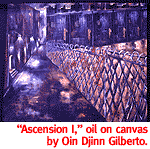 |

An Eclectic Show By Women Artists Is Local 803 Gallery's Last Hurrah.
By Margaret Regan
ROZ EPPSTEIN HAS solid credentials as an abstractionist.
Her three paintings in a group show at the Local 803 gallery
are a fine collection of color-on-color acrylics. These thick
paintings on paper have been rendered in carefully modulated color
combinations: dreamy pinks, peaches and yellows in "The Lost
Moment," more aggressive blue-violet, beige, brown and orange
in "Descending."
Another artist in the show, sculptor Susan Vancas, is sort of
an abstractionist, though her scary-looking pieces in lumber,
driftwood and steel do suggest some kind of horrifying traps.
"Of the Same Grain" seems to be a killer set of metal
man-made jaws about to devour a hapless piece of natural driftwood,
while "Interior Fortification," of driftwood, steel
and ceramic, suggests a lethal cage.
Two artists, two abstractionists, more or less. What's the big
deal? Well, the deal is that these two are part of a 16-woman
show put on by Tucson members of the Arizona Women's Caucus for
Art. And if, given the title of the group, visitors come expecting
to see a showcase of feminist art, they're going to be disappointed.
Because this show, the last ever to be staged by the soon-to-close
Local 803, instead demonstrates the wide-ranging interests of
the caucus' artists. (It also demonstrates the group's wide range
of skill levels.) There are painters, collage artists, photographers,
fabric artists, ceramists, a paper-bag sculptor and a watercolorist,
and they're thinking about everything in art from portraiture
to pure color, from landscape to the imagery of ancient art.
There are several who deal with what we might think of as conventionally
feminist themes. Ellen McMahon and Sheila Pitt, both UA profs,
make use of the ordinary lowly objects that clutter up the female
domestic sphere to make larger points about women's lives. Pitt
displays three unabashedly feminist cloth works, some of which
were seen at the UA faculty show last winter. "Phallocentric
Quilt," a black and white quilt, is printed and stitched
with images of her grandparents' faces in every square, with grandpa
securely and patriarchically in the middle. Pitts makes her stitching
sloppy on purpose, the better to break out of the constraints
of the demure needlework once taught to young girls.
 McMahon shows the latest drawings in her continuing investigations
of motherhood (last summer she showed a maternal alphabet at Dinnerware).
This time, in "Suckled," a series of eight charcoal
drawings on paper, McMahon uses her characteristic fine line to
draw the nipple used on baby bottles. Tugging it into various
shapes, including a phallic one, McMahon suggests just how much
the original suckler--mom--gets torn in all directions.
McMahon shows the latest drawings in her continuing investigations
of motherhood (last summer she showed a maternal alphabet at Dinnerware).
This time, in "Suckled," a series of eight charcoal
drawings on paper, McMahon uses her characteristic fine line to
draw the nipple used on baby bottles. Tugging it into various
shapes, including a phallic one, McMahon suggests just how much
the original suckler--mom--gets torn in all directions.
But by and large the other artists in this show bypass "women's"
themes. In fact, the most explicit socio-political commentary
can be found in some works by African-American artists. Trena
Howard, a young black painter who graduated from the UA a couple
years ago, contributed " Endangered Species No. 2," a
mixed-media piece in which a young African American boy's body
has been made into a target. Jennifer Oshiki has made five provocative
mixed-media wall pieces that attack myths perpetrated against
black Americans. Using text, beaten metal, paint and wood, Oshiki
fashions works like "Nigger Rig." In this piece, a white
picket fence is positioned above a house. Below, down among the
beaten metal, is a flimsy ladder for blacks that serves as an
all-too-rickety vehicle to the American dream.
The rest of the exhibition is a very mixed bag, both thematically
and aesthetically, with the photographers probably making the
strongest showing. Kathleen Velo uses a pinhole camera to make
dreamlike, painterly evocations of the beach in Mexico. "Tide
Pool, Las Conchas" is a distant view of a group of people
inspecting the teaming shore life in Puerto Peñasco. Because
she stood so far away from her subject, and because the pinhole
camera makes such a blurry image, the obscure figures metamorphose
into people in a dream or a vague memory.
Photographer Say Dempsey transfers her gelatin silver prints
to canvas and delicately colors them with an airbrush. But her
images are splintered: Her portrait of the genial older man in
"Muy Tata" is broken up into horizontal bonds that are
out of sync. Similarly, the front of a bus in another piece has
been broken up into six disconcertingly unmatched pieces. Diane
Mansfield Colligan does her familiar sophisticated collages of
a haunting bent, blending pictures from art history into the staircases
and columns of classical architecture.
Among the misses are Scarlett Decker's paintings, emotional,
but poorly painted attacks on the way fairy tales disable us,
and Julie Conrad's spiritually inspired silkscreens on canvas.
In a way, the show is a fitting epitaph for Local 803, which offered
up a real cross-section of Tucson art in the last few years, the
good, the bad and the aspiring. But its commitment to providing
locals with exhibition opportunities was laudable. It will be
missed.
The Arizona Women's Caucus for Art exhibition continues
through June 22 at Local 803 gallery, 803 E. Helen St. Hours are
noon to 5 p.m. Wednesday through Saturday. For more information
call 882-4625.

|
 |
